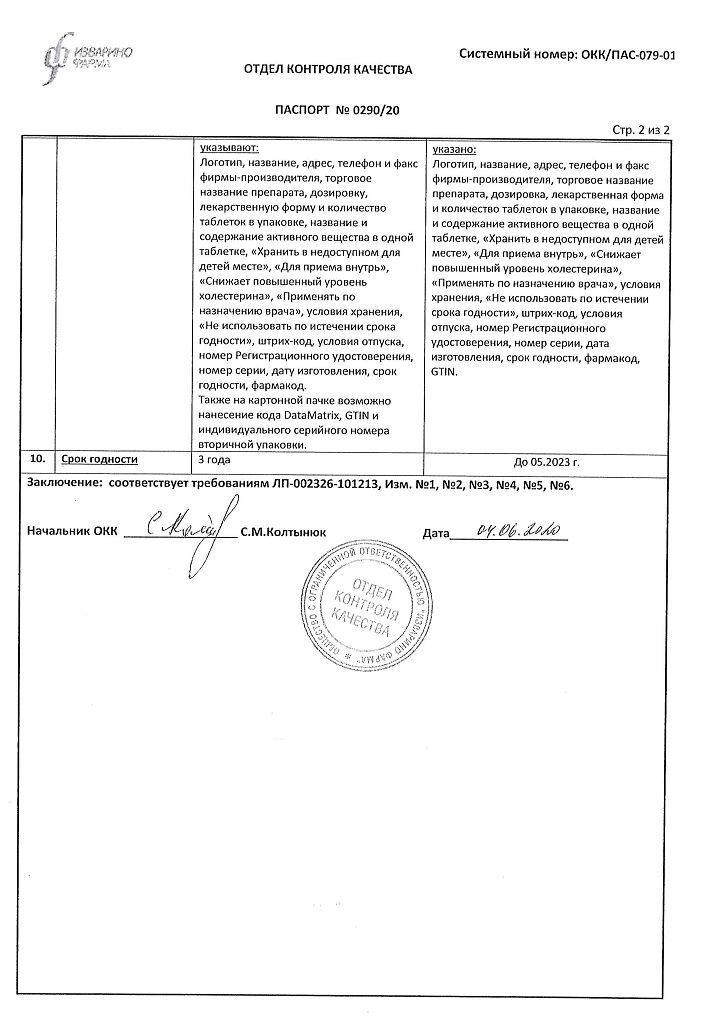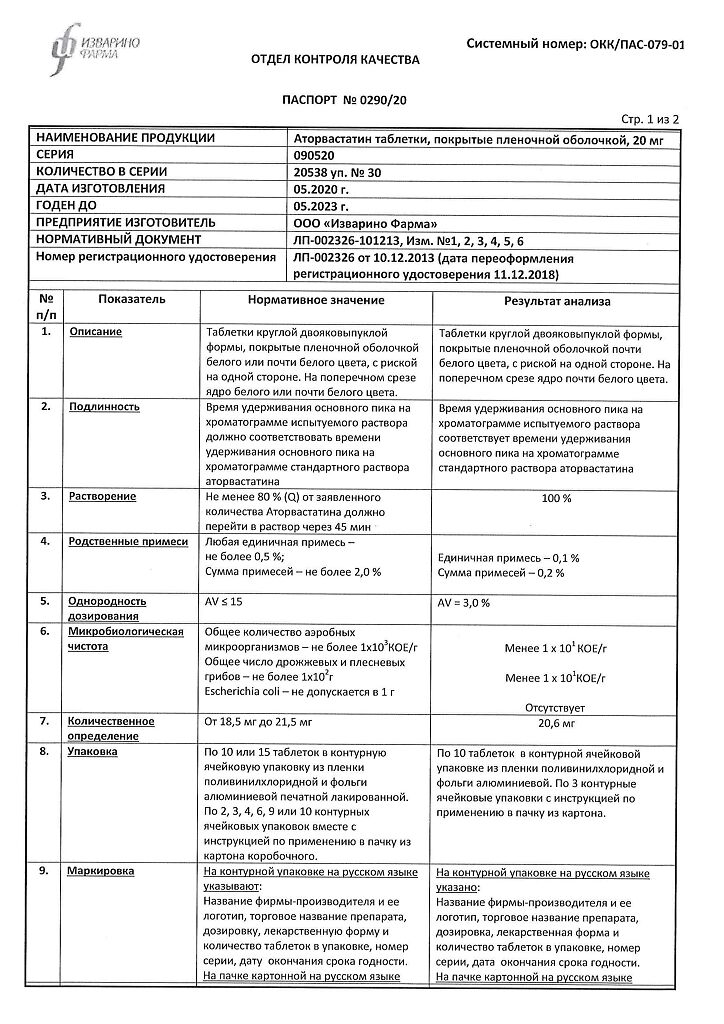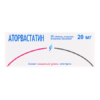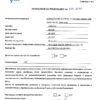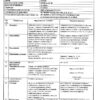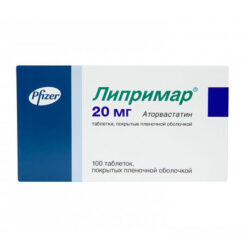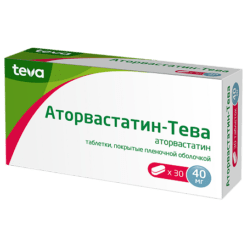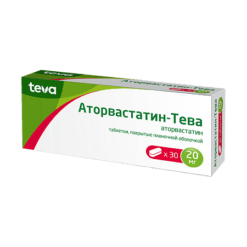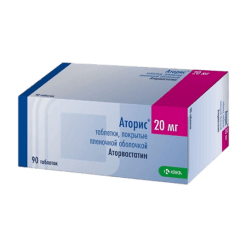No products in the cart.
Atorvastatin, 20 mg 30 pcs
€11.40 €9.98
Description
Pharmacological group: Hypolipidemic drug
Pharmacotherapeutic group: Hypolipidemic drug – HMG-CoA reductase inhibitor
Pharmacological action
Hypolipidemic drug from the group of statins. By the principle of competitive antagonism, statin molecule binds to the part of the coenzyme A receptor where HMG-CoA reductase is attached. The other part of the statin molecule inhibits the conversion of hydroxymethylglutarate into mevalonate, an intermediate product in the synthesis of the cholesterol molecule. Inhibition of HMG-CoA reductase activity leads to a series of sequential reactions resulting in a decrease of intracellular cholesterol content and a compensatory increase of LDL-receptor activity and corresponding acceleration of LDL cholesterol (Xc) catabolism.
The hypolipidemic effect of statins is associated with a decrease in total Xc levels at the expense of LDL Xc. The decrease in LDL levels is dose-dependent and has exponential rather than linear character. Atorvastatin inhibitory effect with respect to HMG-CoA reductase is approximately 70% determined by the activity of its circulating metabolites.
Statin does not affect the activity of lipoprotein and hepatase lipases and has no significant effect on the synthesis and catabolism of free fatty acids, so their effect on TG level is secondary and mediated through their main effects on decrease of HDL-CoA level. A moderate decrease in TG levels during treatment with statins seems to be due to the expression of remnant (apo E) receptors on the surface of hepatocytes involved in catabolism of LDL, which includes approximately 30% TG. Compared with other statins (with the exception of rosuvastatin) atorvastatin causes a more pronounced decrease in TG levels.
In addition to hypolipidemic action, statins have a positive effect in endothelial dysfunction (preclinical sign of early atherosclerosis), on the vascular wall, atheroma condition, improve rheological properties of blood, have antioxidant, antiproliferative properties.
Atorvastatin lowers cholesterol levels in patients with homozygous familial hypercholesterolemia, which usually does not respond to therapy with hypolipidemic agents.
Pharmacokinetics
Atorvastatin is rapidly absorbed from the gastrointestinal tract. Absolute bioavailability is low – about 12%, which is due to presystemic clearance in the gastrointestinal mucosa and/or due to “first passage” through the liver, predominantly at the site of action.
Atorvastatin is metabolized with the participation of CYP3A4 isoenzyme with the formation of a number of substances that are HMG-CoA reductase inhibitors.
The T1/2 from plasma is approximately 14 h, although the T1/2 of HMG-CoA reductase inhibitor activity is approximately 20-30 h, which is due to the participation of active metabolites.
The binding to plasma proteins is 98%.
Atorvastatin is excreted in the form of metabolites mainly in the bile.
Indications
Indications
Primary hypercholesterolemia with ineffective diet therapy, combined hypercholesterolemia and hypertriglyceridemia, heterozygous and homozygous familial hypercholesterolemia with ineffective diet therapy.
Pharmacological effect
Pharmacological effect
Clinical and pharmacological group: Lipid-lowering drug
Pharmacotherapeutic group: Lipid-lowering agent – HMG-CoA reductase inhibitor
Pharmacological action
A lipid-lowering drug from the group of statins. According to the principle of competitive antagonism, the statin molecule binds to the part of the coenzyme A receptor where HMG-CoA reductase is attached. Another part of the statin molecule inhibits the conversion of hydroxymethyl glutarate to mevalonate, an intermediate in the synthesis of the cholesterol molecule. Inhibition of the activity of HMG-CoA reductase leads to a series of sequential reactions, as a result of which the intracellular cholesterol content decreases and a compensatory increase in the activity of LDL receptors occurs and, accordingly, accelerates the catabolism of LDL cholesterol (Xc).
The lipid-lowering effect of statins is associated with a decrease in the level of total cholesterol due to LDL cholesterol. The decrease in LDL levels is dose-dependent and is not linear, but exponential. The inhibitory effect of atorvastatin on HMG-CoA reductase is approximately 70% determined by the activity of its circulating metabolites.
Statins do not affect the activity of lipoprotein and hepatic lipases, do not have a significant effect on the synthesis and catabolism of free fatty acids, therefore their effect on TG levels is secondary and indirect through their main effects on reducing LDL-C levels. The moderate decrease in TG levels during statin treatment appears to be associated with the expression of remnant (apo E) receptors on the surface of hepatocytes involved in the catabolism of DILI, which contain approximately 30% TG. Compared with other statins (except rosuvastatin), atorvastatin causes a more pronounced decrease in TG levels.
In addition to the lipid-lowering effect, statins have a positive effect on endothelial dysfunction (a preclinical sign of early atherosclerosis), on the vascular wall, the condition of atheroma, improve the rheological properties of blood, and have antioxidant and antiproliferative properties.
Atorvastatin lowers cholesterol levels in patients with homozygous familial hypercholesterolemia, which usually does not respond to lipid-lowering drugs.
Pharmacokinetics
Atorvastatin is rapidly absorbed from the gastrointestinal tract. Absolute bioavailability is low – about 12%, which is due to presystemic clearance in the gastrointestinal mucosa and/or due to the “first pass” through the liver, mainly at the site of action.
Atorvastatin is metabolized with the participation of the CYP3A4 isoenzyme to form a number of substances that are inhibitors of HMG-CoA reductase.
T1/2 from plasma is about 14 hours, although T1/2 of the inhibitor of HMG-CoA reductase activity is approximately 20-30 hours, due to the participation of active metabolites.
Plasma protein binding is 98%.
Atorvastatin is excreted in the form of metabolites mainly in bile.
Active ingredient
Active ingredient
Atorvastatin
Composition
Composition
atorvastatin 20 mg.
Excipients:
microcrystalline cellulose – 52.52 mg,
pregelatinized corn starch – 52.51 mg,
colloidal silicon dioxide – 0.38 mg,
magnesium carbonate – 33 mg,
magnesium stearate – 0.75 mg.
Tablet shell composition:
opadry II white (85F18422) – 4.5 mg, (polyvinyl alcohol – 40%, titanium dioxide – 25%, macrogol-3350 – 20.2%, talc – 14.8%).
Contraindications
Contraindications
Liver diseases in the active stage, increased serum transaminase activity by more than 3 times of unknown origin, pregnancy, lactation (breastfeeding), women of reproductive age who do not use reliable contraception; hypersensitivity to atorvastatin.
Side Effects
Side Effects
From the nervous system: > 1% – insomnia, dizziness; <1% - headache, asthenia, malaise, drowsiness, nightmares, paresthesia, peripheral neuropathy, amnesia, emotional lability, ataxia, facial paralysis, hyperkinesis, migraine, depression, hypoesthesia, loss of consciousness.
From the senses: <1% - amblyopia, tinnitus, dry conjunctiva, impaired accommodation, hemorrhage in the retina, deafness, glaucoma, parosmia, loss of taste, taste perversion.
From the cardiovascular system: > 1% – chest pain; <1% - palpitations, symptoms of vasodilation, orthostatic hypotension, increased blood pressure, phlebitis, arrhythmia, angina pectoris.
From the hematopoietic system: <1% - anemia, lymphadenopathy, thrombocytopenia.
From the respiratory system: > 1% – bronchitis, rhinitis; <1% - pneumonia, dyspnea, exacerbation of bronchial asthma, nosebleeds.
From the digestive system: > 1% – nausea; <1% - heartburn, constipation or diarrhea, flatulence, gastralgia, abdominal pain, decreased or increased appetite, dry mouth, belching, dysphagia, vomiting, stomatitis, esophagitis, glossitis, erosive and ulcerative lesions of the oral mucosa, gastroenteritis, hepatitis, biliary colic, cheilitis, duodenal ulcer, pancreatitis, cholestatic jaundice, liver dysfunction, rectal bleeding, melena, bleeding gums, tenesmus.
From the musculoskeletal system: > 1% – arthritis; <1% - leg muscle cramps, bursitis, tenosynovitis, myositis, myopathy, arthralgia, myalgia, rhabdomyolysis, torticollis, muscle hypertonicity, joint contractures, joint swelling, tendinopathy (in some cases with tendon rupture).
From the genitourinary system: > 1% – urogenital infections, peripheral edema; <1% - dysuria (including pollakiuria, nocturia, urinary incontinence or urinary retention, urinary urgency), leukocyturia, nephritis, hematuria, vaginal bleeding, nephrourolithiasis, metrorrhagia, epididymitis, decreased libido, impotence, ejaculation disorder.
Dermatological reactions: > 1% – alopecia, xeroderma, photosensitivity, increased sweating, eczema, seborrhea, ecchymosis, petechiae.
From the endocrine system: <1% - gynecomastia, mastodynia.
From the metabolic side: <1% - increase in body weight, exacerbation of gout.
Allergic reactions: <1% - itching, skin rash, contact dermatitis, rarely - urticaria, angioedema, facial swelling, anaphylaxis, erythema multiforme (including Stevens-Johnson syndrome), toxic epidermal necrolysis (Lyell's syndrome).
Laboratory indicators: <1% - hyperglycemia, hypoglycemia, increased serum CPK, albuminuria.
Interaction
Interaction
With simultaneous use of atorvastatin with digoxin, the concentration of digoxin in the blood plasma slightly increases.
Diltiazem, verapamil, isradipine inhibit the CYP3A4 isoenzyme, which is involved in the metabolism of atorvastatin, therefore, when used simultaneously with these calcium channel blockers, it is possible to increase the concentration of atorvastatin in the blood plasma and increase the risk of developing myopathy.
With simultaneous use of itraconazole, the concentration of atorvastatin in the blood plasma increases significantly, apparently due to the inhibition of its metabolism in the liver by itraconazole, which occurs with the participation of the CYP3A4 isoenzyme; increased risk of developing myopathy.
With simultaneous use of colestipol, it is possible to reduce the concentration of atorvastatin in the blood plasma, while the lipid-lowering effect is enhanced.
When used concomitantly, antacids containing magnesium hydroxide and aluminum hydroxide reduce the concentration of atorvastatin by approximately 35%.
With simultaneous use of cyclosporine, fibrates (including gemfibrozil), antifungal drugs of azole derivatives, nicotinic acid, the risk of developing myopathy increases.
With simultaneous use of erythromycin and clarithromycin, the plasma concentration of atorvastatin moderately increases and the risk of developing myopathy increases.
With the simultaneous use of ethinyl estradiol and norethisterone (norethindrone), the concentration of ethinyl estradiol, norethisterone and (norethindrone) in the blood plasma increases slightly.
With simultaneous use of protease inhibitors, the concentration of atorvastatin in the blood plasma increases, because Protease inhibitors are inhibitors of the CYP3A4 isoenzyme.
Manufacturer
Manufacturer
Izvarino Pharma, Russia
Additional information
| Manufacturer | Izvarino Pharma, Russia |
|---|---|
| Medication form | pills |
| Brand | Izvarino Pharma |
Other forms…
Related products
Buy Atorvastatin, 20 mg 30 pcs with delivery to USA, UK, Europe and over 120 other countries.


